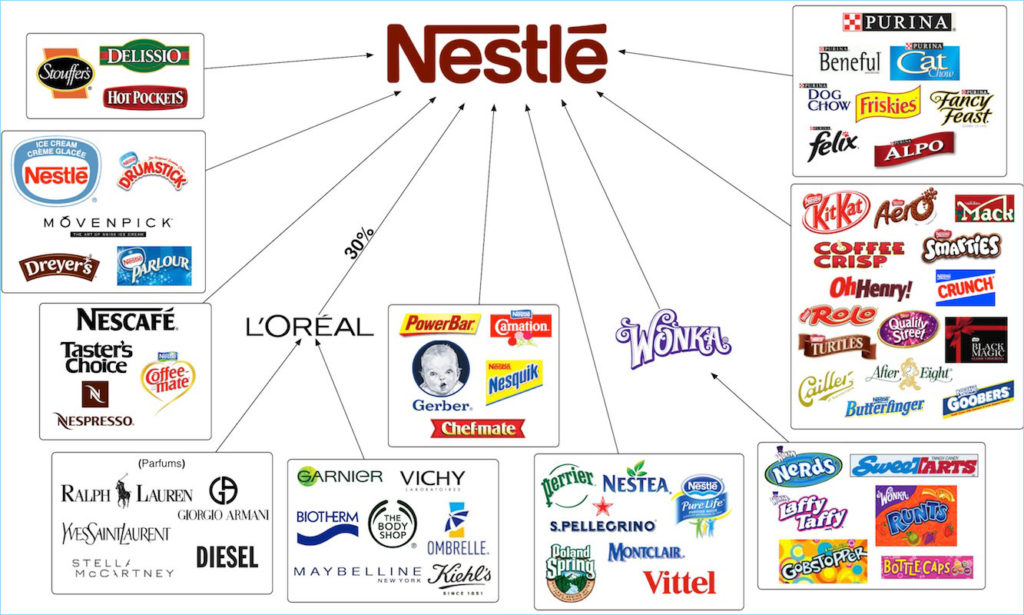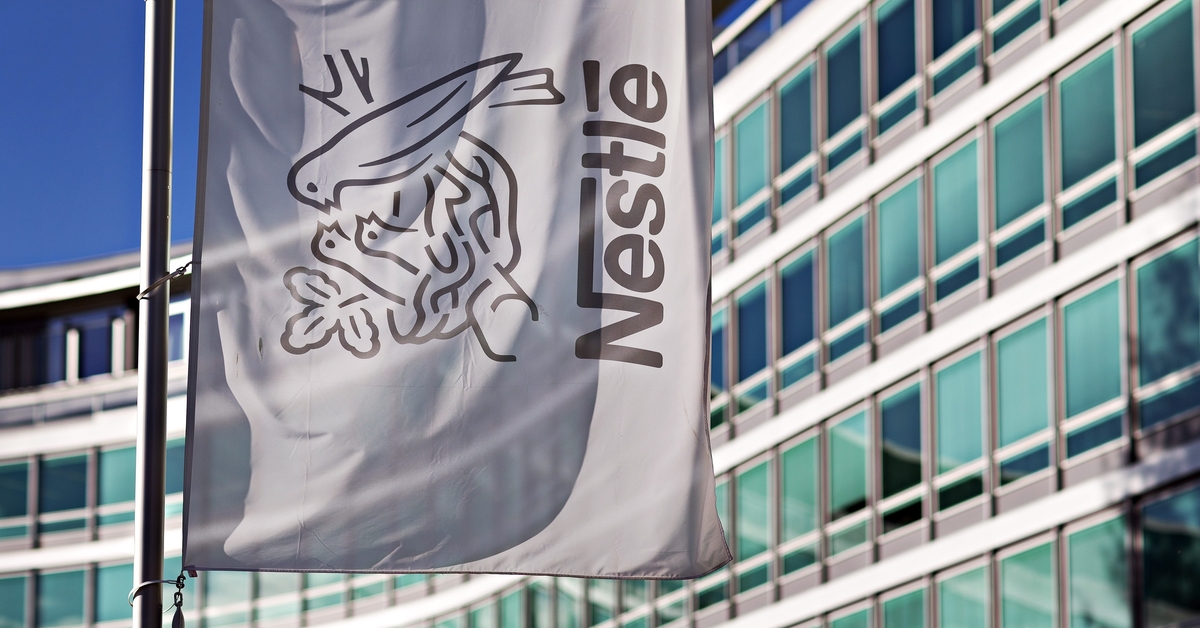Rarely do we come across a brand that impacts our lives every day in uncountable ways. One such brand is Nestle. It is currently the largest food company in the world, measured by revenues and other metrics. As of 2019, Nestlé employees over 291,000 in 187 different countries with sales of $92.6 billion (In CHF). In 2017, it ranked 64 on the Fortune Global 500 and secured 33rd rank on the 2016 edition of the Forbes Global 2000 list of largest public companies.
Nestle carries one of the heaviest product portfolios, including baby food, confectionery, dairy products, ice cream, coffee and tea, pet foods, frozen food, medical food, bottled water, breakfast cereals, and snacks. Twenty-nine of Nestle’s brands have an annual sale of over CHF $1 billion, some of the more famous ones are Nespresso, Nescafé, Kit Kat, Smarties, Nesquik, Stouffer’s, Vittel, and Maggi. In 1974, it also became one of the principal shareholders of L’Oreal, the world’s largest cosmetics company.
Read the company’s annual financial report here.
History
The foundations of Nestlé were laid in 1867, when Henri Nestle, an assistant to a local pharmacist, innovated a nutritious combination of milk, wheat, and sugar. This cereal was so nutritious that it saved the life of a child. He called it ‘Farine lactee.’ A combination of his business acumen and quality products resulted in the impressive growth of the business. By 1875, Nestle products could be found across the globe.
In the last decades of the 19th century, fierce competition developed between Nestle and Anglo-Swiss condensed milk company, the later was started in 1866 and was the first condensed milk factory in Europe opened in Cham, Switzerland. When both the companies began selling rival versions of the other’s original products condensed milk and infant cereal. Both firms eventually merged into the Nestlé, that we know today.
A survivor of World Wars and the Great Depression
Many industries in Europe were severely disrupted between 1914 and 1918 due to World War I. Even though Switzerland was not involved directly in the war; it was proving difficult for Nestlé to find the raw material needed to continue manufacturing like before. To survive this period of economic hardship, it acquired several government contracts that required them to expand rapidly. When the war came to an end in 1918, it had over 40 factories across the globe.
During the economic crash of the 1920s, despite the difficulties and financial hardships, the company was able to survive by acquiring Calliet, Peter, and the Kohler Swiss chocolate company in the mid-1920s. It was at this point that chocolate became one of the central focuses of its business.
Product Division
The organization has products for every facet of life – from infant to adulthood; there’s not a single element of a person’s life that the company hasn’t touched.
The various brands under Nestlé are as follows:
- Baby foods: Gerber, NaturNes, Cerelac
- Bottled water: Perrier, Poland Spring, S.Pellegrino Nestlé Pure Life
- Cereals: Lion, Nesquik Cereal, Cheerios, Fitness
- Chocolate & confectionery: KitKat, Milkybar, Aero, Cailler, Nestlé Les Recettes de l’Atelier, Orion, Quality Street, Smarties, Toll House
- Tea & Coffee: CoffeNescafé, Nescafé 3 in 1, Nescafé Decaff, Nescafé Dolce Gusto, Nescafé Gold, Nespresso, Nescafé Cappuccino, Nescafé Classic
- Culinary, chilled and frozen food: Maggi, Stouffer’s, Thomy, Buitoni, Herta, Hot Pockets, Lean Cuisine
- Dairy: Carnation, Coffee-Mate, La Laitière, Nido
- Drinks: Milo, Nesquik, Nestea
- Foodservice: Nestea, Sjora, Lean Cuisine, Stouffer’s Chef, Chef-Mate, Maggi, Milo, Minor’s, Nescafé,
- Healthcare Nutrition: Boost, Nutren Junior, Peptamen, Resource
- Ice cream: Mövenpick, Nestlé Ice Cream, Dreyer’s, Extrême, Häagen-Dazs
- Petcare: Fancy Feast, Felix, Friskies, Gourmet, Purina, Purina ONE, Pro Plan Alpo, Bakers Complete, Beneful, Cat Chow, Chef Michael’s Canine Creations, Dog Chow

Competitors
The chief competitors of Nestlé in India are Unilever and Procter & Gamble. In the coffee segment, Nescafe and Unilever’s Bru share around 98-99% of the market, while Tata’s Tata Coffee and ITC’s Sunbean are the latest entrants.
In the instant noodles segment, Maggi currently enjoys 60% of the market, with ITC’s Yippie, Knorr, and Patanjali’s Aata Noodles being its chief competitors.
The Maggi Crisis: When India’s ‘National Food’ was found out to be poisonous
In April 2015, a government referral laboratory in Kolkata, following up on an initial report, reported MSG and excess lead in samples of Maggi, the product was pulled from the market and banned by the Indian government in June 2015.
At the time, around 35000 Tonnes of Maggi worth 500 crores was destroyed. Nestlé reported a net quarterly loss for the first time in India in June 2015, since about 30% of its revenue came from Maggi.
When the ban was lifted, the FMCG giant restarted from scratch. The priority was to rebuild the trust and reputation block-by-block by engaging and communicating with stakeholders transparently and continuously. They introduced scores of new products and variants to build a balanced portfolio and reduce dependence on a single product. They included six new variants of Maggi called HotHeads, a chocolate wafer with peanuts, and ready-to-drink premixes.
They also increased the company’s emphasis on health and nutrition, simplified the corporate structure, and increased advertising. But the main ingredient for success was improved PR and communications. To increase focus on the market, Nestlé has decentralized the decision-making process by creating 15 verticals that now target specific geographies with their hyper-local strategies.
With a perfect blend of emotions and simplicity, Maggi addressed its loyalists by the digital campaign, “We miss you too.”
“Kab wapas ayegaa yaar? Miss you.”, “I miss you, yaar. Come back, man.”, “Ab aa bhi jao. Miss you yaar.”. These were the lines in a three-film digital campaign released by Maggi. The ads were monologues by young men who’re addressing Maggi resembling a series of personal messages to an old buddy.
Also, under this initiative, a series of videos were launched on YouTube, where mothers narrated the story about when and how their young ones tasted Maggi for the first time and what their reactions and experience were, adding nostalgia and creating an emotional connection with the audience.
For selling Maggi initially Nestlé partnered with Snapdeal to sell Welcome back Maggi Kit pack, this kit contained 12 packets of Maggi noodles, a Maggi fridge magnet, 2016’s calendar, and a Maggi welcome back letter. Within the first five minutes, 60,000 kits were sold, and within the initial ten days, 3.3 crore units of Maggi packets were sold, indicating how much people missed Maggi. Within a year after its re-launch, Maggi was able to capture 60% of the instant noodles market, an enormous feat.
Strategies and Reason for Success
1) Substantial Direct Investment in advanced foreign markets: Nestlé’s international market penetration strategies are associated with direct foreign investment in food or other dairy business. For instance, operating in the advanced market, its policy is to invest directly in the big companies, or to establish a strategic alliance with larger companies. In the less developed markets, Nestlé grows by using an aggressive acquisition policy. For example, it acquired Kit Kat from Rowntree in 1988 and Kraft Foods’ frozen pizza business in 2010
2) Iconic Branding: Over the years, Nestlé has given some of the most iconic taglines which resonate with the audience throughout their lifetime, from Nescafe’s ‘It all starts with a Nescafe,’ Maggi’s ‘2-minute noodles’ to KitKat’s ‘Have a break, Have a KitKat.’ Along with superior quality products, it also uses beautiful packaging to attract its customers.
3) Broad product portfolio: The company concentrates on its consumers and tries to understand their emotional and physical desires. They have a wide range of products which are consumed by all age groups. For example, Nestlé has used its research and technological expertise to lower their calories and fats and yet to have the same taste in their ice cream products.
4) People to people connect: Nestlé also tries to understand the motivations, routines, decision making, and purchasing habits of the customers by spending time with the people. For example, In Peru, Nestlé employees spent three days living with people in the suburbs of Lima to understand the everyday aspects of their life, and based on this understanding, they created and sold relevant products in the local markets and malls.
Controversies and Criticisms
Even with such a glorious past and present, all is not gold for the company. It has significant shares of controversies in various markets. For instance, the concerns are there about Nestle’s “aggressive marketing” of their breast milk substitutes, particularly in less economically developed countries (LEDCs),
Also, multiple reports have documented the widespread use of child labor in cocoa production, as well as slavery and child trafficking, throughout West African plantations, on which Nestlé and other major chocolate companies rely.
In 2007, the Competition Bureau of Canada raided the offices of Nestle Canada, Hershey Canada, and Mars Canada to investigate the matter of price fixing of chocolates. It is alleged that executives of these companies conspired to inflate prices.
Nestle and the other companies were subject to class-action lawsuits for price-fixing. Nestlé settled for $9 million, without admitting liability.
These cases are only a tip of the iceberg of the controversies and criticisms that the company had been subject to.
But despite the numerous lawsuits and calls for boycott, however, Nestle has become more prominent than ever, owning over 200 different brands across the world. Since people are unlikely to give up on Nestlé’s delicious goodies anytime soon, it’s safe to say that it will continue expanding in the future, making good life with good foods.

